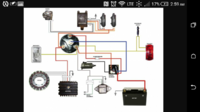deadxramones
XS400 Member
So I found a trimmed down schematic for an 81 and I've followed it making my own slight modifications to fit what I need and I'm using a stock key ignition but otherwise I stuck to it.my question is that there is only one fuse on the main power wire can I run it like that? I understand if it pops nothing will work but do I run the risk of frying stuff or if something grounds out anywhere will it still pop and still save my harness? My gut says no but I like less bulk by not routing to fuse block . I've also seen single fuse harnesses sold but custom shops so it has me wondering. I'm not a eletrcal guru so any help is awesome.

